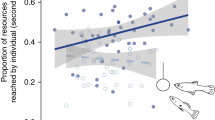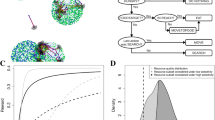Abstract
We study interactions between resource distributions, grouping, and diet development in foragers who learn by trial-and-error. We do this by constructing an individual-based model where individuals move and forage in groups in a 2-D space with high resource diversity and learn what to eat. By comparing diet development in different resource distributions, and in gregarious and solitary individuals, we elucidate how these factors affect patterns of diet variation. Our results indicate that different resource distributions have profound effects on learning opportunities, and thereby lead to contrasting phenomena. In uniform environments, local resource depletion by gregarious individuals, in interaction with learning, leads to diet differentiation. In patchy environments, grouping leads to enhanced diet overlap within groups and leads to differences in diet between groups. Surprisingly, mixed environments can generate all these phenomena simultaneously. Our results predict relationships between diet variation, trial-and-error learning, and resource distributions. The phenomena we describe are not evolved strategies, but arise spontaneously when groups of individuals learn to forage in certain resource distributions. This suggests that describing diet specialization or diet homogenization as the result of behavioral strategies may not always be justified.
Similar content being viewed by others
References
Altmann SA (1998) Foraging for survival. University of Chicago Press, Chicago, IL
Birch LL (1999) Development of food preferences. Annu Rev Nutr 19:41–62
te Boekhorst I, Hogeweg P (1994) Self-structuring in artificial ‘CHIMPS’ offers new hypotheses for male grouping in chimpanzees. Behaviour 12:229–252
Bolnick DI, Yang LH, Fordyce JA, Davis JM, Svanbäck R (2002) Measuring individual-level trophic specialization. Ecology 83:2936–2941
Bolnick DI, Svanback R, Fordyce JA, Yang LH, Davis JM, Hulsey CD, Forister ML (2003) The ecology of individuals: incidence and implications of individual specialization. Am Nat 161:1–28
Boyd R, Richerson R (1988) An evolutionary model of social learning: the effects of spatial and temporal variation. In: Zentall T, Galef BG Jr (eds) Social learning: psychological and biological perspectives. Erlbaum, Hillsdale, pp 29–48
Chapman CA, Fedigan LM (1990) Dietary differences between neighboring Cebus capucinus groups: local traditions, food availability or responses to food profitability? Folia Primatol 54:177–186
Chapman CA, Chapman LJ, Wrangham R, Isabirye-Basuta G, Ben-David K (1997) Spatial and temporal variability in the structure of a tropical forest. Afr J Ecol 35:287–302
Chapman CA, Chapman LJ, Gillespie TR (2002) Scale issues in the study of primate foraging: red colobus of Kibale National Park. Am J Phys Anthropol 117:349–363 DOI 10.1002/ajpa.10053
Deneubourg JL, Goss S, Franks N, Pasteels JM (1989) The blind leading the blind: modelling chemically mediated army ant raid patterns. J Insect Behav 2:719–725
Duncan AJ, Young SA (2002) Can goats learn about foods through conditioned food aversions and preferences when multiple food options are simultaneously available? J Anim Sci 80:2091–2098
Emlen S, Oring L (1977) Ecology, sexual selection, and the evolution of mating systems. Science 197:215–223
Feldman MW, Aoki K, Kumm J (1996) Individual versus social learning: evolutionary analysis in a fluctuating environment. Anthropol Sci 104:209–232
Fragaszy DM, Visalberghi E (1996) Social learning in monkeys: primate “Primacy” reconsidered. In: Galef BG Jr, Heyes C (eds) Social learning in animals: the roots of culture. Academic, New York, pp 65–84
Galef BG (1988) Imitation in animals: history, definition, and interpretation of data from the psychological laboratory. In: Zentall T, Galef BG Jr (eds) Social learning: psychological and biological perspecitives. Erlbaum, Hillsdale, pp 3–28
Galef BG, Giraldeau L-A (2001) Social influences on foraging in vertebrates: causal mechanisms and adaptive functions. Anim Behav 61:3–15 DOI 10.1006/anbe.2000.1557
Garcia J, Hankins WG, Rusiniak KW (1974) Behavioral regulation of the milieu interne in man and rat. Science 185:824–831
Hasegawa Y, Matsuzawa T (1981) Food-aversion conditioning in Japanese monkeys (Macaca fuscata): a dissociation of feeding in two separate situations. Behav Neural Biol 33:237–242
Hemelrijk CK (2000) Towards the integration of social dominance and spatial structure. Anim Behav 59:1035–1048
Heyes CM (1994) Social learning in animals: categories and mechanisms. Biol Rev 69:207–231
Hinton GE, Nowlan SJ (1987) How learning can guide evolution. Complex Syst 1:495–502
Hogeweg P, Hesper B (1985) Socioinformatic processes: MIRROR modelling methodology. J Theor Biol 113:311–330
Karasov WH, Diamond JM (1988) Interplay between physiology and ecology in digestion. BioScience 38:602–611
Kimball BA, Nolte D (2005) Herbivore experience with plant defense compounds influences acquisition of new flavor aversions. Appl Anim Behav Sci 91:17–34 DOI 10.1016/j.applanim.2004.10.001
Matsuzawa T, Hasegawa Y (1983) Food aversion learning in Japanese monkeys (Macaca fuscata). A strategy to avoid a noxious food. Folia Primatol 40:247–255
Mead R, Curnow RN, Hasted AM (1993) Statistical methods in agriculture and experimental biology, 2nd edn. Chapman & Hall, London, UK
Provenza FD (1995) Postingestive feedback as an elementary determinant of food preference and intake in ruminants. J Range Manag 48:2–17
Rogers AR (1988) Does biology constrain culture? Am Anthropol 90:819–831
Author information
Authors and Affiliations
Corresponding author
Additional information
Communicated by S. Alberts
Rights and permissions
About this article
Cite this article
van der Post, D.J., Hogeweg, P. Resource distributions and diet development by trial-and-error learning. Behav Ecol Sociobiol 61, 65–80 (2006). https://doi.org/10.1007/s00265-006-0237-6
Received:
Revised:
Accepted:
Published:
Issue Date:
DOI: https://doi.org/10.1007/s00265-006-0237-6




